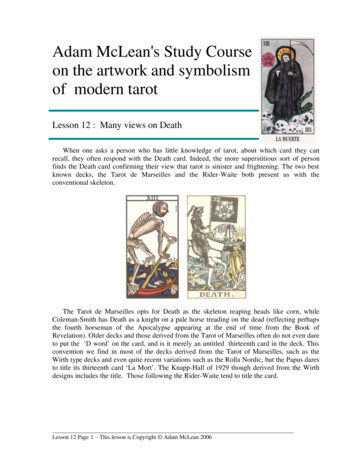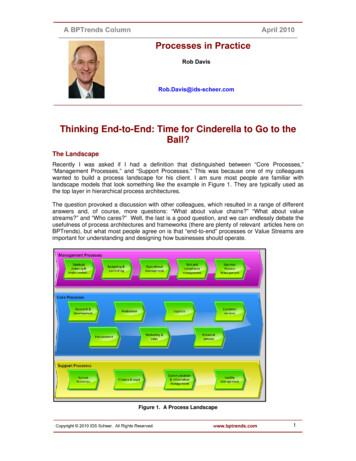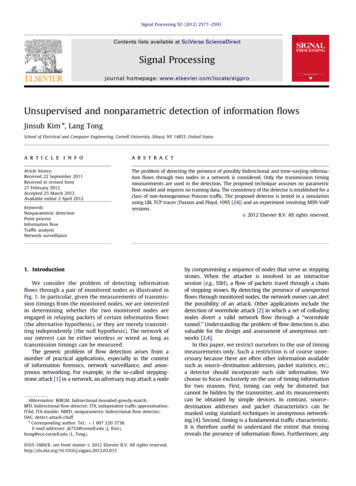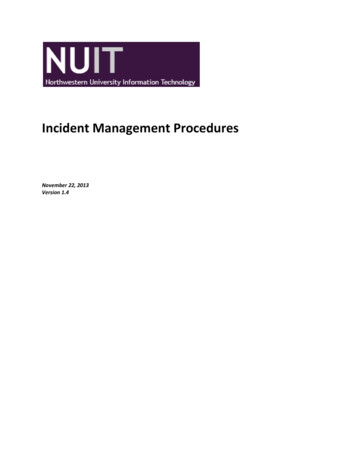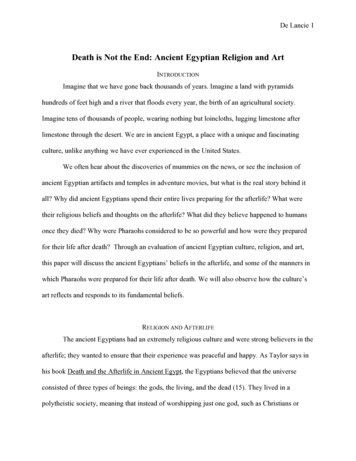
Transcription
De Lancie 1Death is Not the End: Ancient Egyptian Religion and ArtINTRODUCTIONImagine that we have gone back thousands of years. Imagine a land with pyramidshundreds of feet high and a river that floods every year, the birth of an agricultural society.Imagine tens of thousands of people, wearing nothing but loincloths, lugging limestone afterlimestone through the desert. We are in ancient Egypt, a place with a unique and fascinatingculture, unlike anything we have ever experienced in the United States.We often hear about the discoveries of mummies on the news, or see the inclusion ofancient Egyptian artifacts and temples in adventure movies, but what is the real story behind itall? Why did ancient Egyptians spend their entire lives preparing for the afterlife? What weretheir religious beliefs and thoughts on the afterlife? What did they believe happened to humansonce they died? Why were Pharaohs considered to be so powerful and how were they preparedfor their life after death? Through an evaluation of ancient Egyptian culture, religion, and art,this paper will discuss the ancient Egyptians’ beliefs in the afterlife, and some of the manners inwhich Pharaohs were prepared for their life after death. We will also observe how the culture’sart reflects and responds to its fundamental beliefs.RELIGION AND AFTERLIFEThe ancient Egyptians had an extremely religious culture and were strong believers in theafterlife; they wanted to ensure that their experience was peaceful and happy. As Taylor says inhis book Death and the Afterlife in Ancient Egypt, the Egyptians believed that the universeconsisted of three types of beings: the gods, the living, and the dead (15). They lived in apolytheistic society, meaning that instead of worshipping just one god, such as Christians or
De Lancie 2Muslims do, they worshipped many different gods and goddesses. These entities were veryimportant to Egyptians because, as Casson states in his book Everyday Life in Ancient Egypt,“every detail of [an individual’s] own life, [ ] whether the annual inundation of the Nile [ ] orthe chance death of his cat, was a specific, calculated act of god” (84). In other words, the godswere spiritual beings that determined humans’ fates, and everything happened because theywilled it. When something bad happened, for instance, humans could blame the gods, and whensomething good happened, they could thank them. The gods each had their own specialcharacteristics and played a specific role in Egyptian society. The goddess Hathor, for example,was responsible for love and childbirth (similar to the Greek Aphrodite) (Taylor 85). She wasdepicted with a human body and a head with cow horns. The god Khnum, on the other hand, waslinked to creation; he was a man with a ram’s head “often portrayed as a divine potter modelingmen on a potter’s wheel” (Taylor 86).Not only did the ancient Egyptians believe in many gods and goddesses, they also had avery interesting view on death. While some of us may understand the death of our bodies asbeing the termination of our selves, the Egyptians believed that death was not equal to an end,but a change into a different kind of existence (Taylor 12). They “conceived of [death] assomething to be enjoyed” and refused to “see in it an end to the stuff of life” (Casson 119;Andreu 148). Put simply, rather than dreading death and seeing it as an end, Egyptians acceptedit as a continuation into another form of existence. They believed that life was a temporary stage,merely a transitional period into an eternal and more fulfilling afterlife (“Concept of theAfterlife”). Since life was only transitional and the afterlife was eternal, it was very important forEgyptians to, during their time on earth, “[prepare] the body and soul for a peaceful life after
De Lancie 3death” (“Religion”). By preparing their body and soul, the ancient Egyptians ensured that theireternal afterlife was a pleasant one.THE DIFFERENT PARTS OF A HUMANTo better understand the ancient Egyptians’ beliefs in the afterlife and why they tooksuch great care in preparing their body and soul for the afterlife, we must first examine thedifferent parts that they believed humans to be consisted of. There are many religions, such asJudaism, Buddhism, and Christianity which believe that humans are composed of two parts: thebody and the soul. The ancient Egyptians, however, believed there were more to humans thanthese two elements. They “perceived man as a composite of physical and non-physical elements”and thought that humans consisted of six entities (Taylor 16). The body was the physical part,and the shadow, the name, the spirit (ka), the personality (ba), and immortality (akh) wereconsidered the non-physical parts.In Taylor’s account of the name, he explains that it was an important aspect of someone’sindividuality (23). The name in ancient Egypt was the same as it is now: a word we use to callsomeone. Since names set people apart from one another, they are individualistic. Taylorexplains that the creation and preservation of a human’s name was crucial because it was one ofthe things that made their survival after death possible: “Since the name was so closely linkedwith the prosperity of the bearer, survival of death was linked to the remembrance of the name”(23). In other words, the deceased could continue to live as long as their name was remembered.Given that a person’s name was so important, it was placed on statues and in the coffins ofmummies in order for an individual to be recognized once dead. During offerings to thedeceased, the name had to be uttered so that the ka knew where to receive its nourishment (“TheConcept of the Soul” para 15).
De Lancie 4For ancient Egyptians, the ba, the shadow, and the akh were also important parts of whatit meant to be human. The ba can be described simply as an individual’s personality. It wasbelieved that the ba could “leave the body temporarily by way of dreams and visions” (Casson118). It could travel between the world of the living and the world of the dead, but if it did notreturn to the body regularly, every night, for instance, then it would not survive (“Treatment ofthe Dead” para 3). Even upon death of the body, the movement of the ba continued. Like the ba,the shadow could separate from the body and move around freely (Taylor 24). Since each personcasts a different shadow and no two are alike, the shadow makes a human unique. The akh isdescribed as a person’s immortality and, unlike the other elements, it was “not joined at birth”(Coons 2). Instead, it was “created after death through the use of spells and text read at thefuneral” (Coons 2). So, where the name, shadow, ka, and ba were with a human from the time oftheir birth, the akh only resulted upon an individual’s death.According to Taylor, the “most important of the non-physical aspects of man was the ka”(18). In their book Gardner’s Art Through the Ages, Kleiner and Mamiya explain that the ka wasbelieved to be created at the moment of birth by the ancient Egyptian deity Khnum and ishieroglyphically symbolized by upraised human arms (45) (see Figure 1). The ka can also bedescribed as the life force behind humans. Egyptians believed that once the body died, the kacould continue to live forever, as long as it had a place to inhabit (Kleiner and Mamiya 45).Since a body begins to disintegrate upon death, Egyptians had to find ways to preserve thehuman body so as to maintain a home for the ka. Embalming techniques emerged to preserve thebody and ka statues were created in case something should happen to the mummified body, aswe will discuss later.
De Lancie 5Figure 1: Thehieroglyphicsymbol for the ka.PHARAOHSOf all the individuals in ancient Egypt, the Pharaohs’ parts of the body held the mostimportance, as Pharaohs were a very significant aspect of the culture’s religion, art, and politics.For hundreds of years now, the United States has been living under the government of ademocracy, in which the president is elected by the public. In ancient Egypt, however, they livedin a monarchy, which was common for those times. In a monarchy, one individual holds thesupreme power; in the case of Egypt, the ruler was called a Pharaoh. The word “Pharaoh” is aGreek word for the ancient Egyptian “Great House,” since it referred to the king and his palacerather than just the king himself (“Pharaoh”).Pharaohs were the divine rulers of a united ancient Egypt. In her book Egypt in the Ageof the Pyramids, Andreu says that “by divine right, the monarch governed [ ] Upper and LowerEgypt united under his authority” (1). They were believed to be men who were both religiousand political leaders, as well as gods (Casson 87). By virtue of their divinity, Pharaohs were thecommunicators between the humans and their gods. Their divinity also gave them much powerand their role was to impose order and prevent chaos on earth (Egyptology); consequently, the“death of a king was a disaster befalling the land” (Andreu 14). When a Pharaoh died, he wasbelieved to be joining the other gods (Casson 87). Furthermore, unlike the elections we have inthe United States, where the president is chosen by the people, Pharaohs came to power throughdivine right; in other words, the son of a Pharaoh replaced his father as ruler. The public
De Lancie 6therefore had no say in who became their leader, but this did not appear to be a problem since itwas accepted that the rulers were chosen by the gods themselves.MUMMIFICATION: PRESERVING THE BODYOne of the ways that Pharaohs—and later less powerful or affluent individuals as well—were prepared for the afterlife upon death was through a process called mummification.Mummification emerged in the Fourth Dynasty BCE as a way of preserving the deceased’s body.With a preserved body, some of the non-physical elements of an individual could have a place toreside: “If the spiritual and physical elements of the individuals were to be reunited after death, itwas necessary to preserve the integrity of their fleshly container and avoid its decay at any cost”(Andreu 145). Performed by embalmers, mummification was a gruesome yet remarkableprocedure.As Greek historian Herodotus explains in a passage about mummification, before theembalmer could begin the removal of the deceased’s organs, the people who brought him thebody had to say what grade of mummification they wanted to use (Casson 122). There werethree grades: there was the finest grade, which was clearly the best and most expensive, therewas the second grade, which was cheaper, and then there was the third grade, which was thesimplest and cheapest. The embalmer and those who brought the body also had to come to anagreement on a price to be paid (Casson 122). Since Pharaohs were divine and powerful beings,they were undoubtedly always treated with the finest grade of embalming, which consisted of along and bloody process.After many excavations and much research, scholars have been able to uncover theprocess of mummification. To begin with, no matter what grade was used, the heart of thedeceased was left in place because it was considered to be very important. It was regarded as the
De Lancie 7core of intelligence and necessary for survival, as well as “the center of the individual, bothanatomically and emotionally” (Taylor 17). Perhaps contrary to what might be presentlybelieved, the brain did not appear to have any special significance to the Egyptians; it wasextracted through the nostrils with the use of an iron instrument and simply discarded. Next, anincision was made in the flank through which the lungs, liver, stomach, and intestines wereextracted. The reason these organs were removed was because they were seen as being able todecay easily. They were wrapped individually and placed in what were called canopic jars.Canopic jars were made out of wood or stone and were typically in sets of four, one for each ofthe four organs (see figure 2). Canopic jars were important because they were seen as a “magicalprotection for the organs” and were placed in the tomb with the deceased. (Casson 122; Kleinerand Mamiya 45; “Treatment of the Dead”)Figure 2- Canopic jars in whichthe organs of the deceased areplaced to be protected.(“Treatment of the Dead”)The hole in the abdominal cavity was then filled with resin-soaked linens and sewn up.After sewing up the body, it was put in a naturally occurring salt compound, called natron.Natron was used to dry the bodies’ tissues and thus dehydrate it. In Herodotus’ account ofmummification, the soaking of the body in natron was a procedure that took seventy days, butaccording to Kleiner and Mamiya, it only took forty days. In Casson’s view, the number of dayswas a “matter of religious belief,” so it could very well have been forty, seventy, or a number ofdays somewhere in between these two figures (123). In any case, when the dehydration of the
De Lancie 8body was complete, the embalmer washed the corpse and then applied lotions to it. With thebody now clean, the embalmer could finally wrap it up with bandages made of fine linens. SinceEgyptians did not have glue, they wrapped the bandages in gum instead, which worked just aswell. Unfortunately, not everyone could afford the most expensive grade of mummification. Forthe lower class or for those who simply wanted to minimize expenses, one of the other twogrades of mummification was used. In these lesser grades, there was no removal of the organs,making the process simpler and quicker. (Casson 123; Kleiner and Mamiya 45)As demonstrated with their use of mummification, the Egyptians’ view of death and theafterlife was at the same time a unique and serious aspect of their culture. For ancient Egyptians,ensuring a proper preparation for the afterlife was extremely important, and the fact that theyperformed mummification shows the lengths they would go to for something they believed in sostrongly. It is hard to imagine anyone doing such a procedure in our present day society; a simpleburial or cremation of the body appears to be commonplace. This shows that, although death is ahard and painful moment for all of us, the afterlife is not generally recognized in our culture.While present-day dealings with the body, particularly in the United States, reflect our culture’sdisregard or disinterest in a life after death, the process of mummification in ancient Egyptreflects a contrary belief that the afterlife was most important.ART AND KA STATUESIn addition to mummification, art was crucial to preparing for the afterlife in ancientEgyptian civilization. However, art was not perceived in the same manner as it is today. While inour society we see art as something creative or aesthetically pleasing to the eye, the art of theEgyptians was deeply integrated into their religion and beliefs: “Egypt’s glorious artisticcreations were inspired by religion and religion alone” (Casson 84). As discussed in Ancient
De Lancie 9Egypt, “Egyptian artisans produced some of the most spectacular art ever made, yet their culturehad no word for art and no concept of art for art’s sake” (Silverman 212). In other words, we calltheir statues and paintings art, but the Egyptians were not even producing these works for anaudience to view—their art was purely for religious and functional purposes. Andreu says that a“statue was intended to follow its subject into the afterlife as its exact double” (63); statues werenot created to be looked at, but they were made to replace the body of a person once they died.For a while, it was only Pharaohs who could afford to have statues and paintings created for theirtombs, but as time progressed, people from lower classes were able to afford these creations aswell.Sculptors in ancient Egypt were respected and highly valued. They were described ingreat ways, such as a “fashioner of life” and a “modeler of forms” (Andreu 63). Sculptors werevital in ancient Egyptian society due to the fact that “a statue erected in tomb or temple was away of ensuring an individual’s existence for eternity after death” (Casson 84). Without them,the statues which were so crucial to Egypt’s religion and to their preparation for the afterlifewould not have existed. If there were no sculptors to make statues, where would the ka reside?There was always mummification, but for the Egyptians, that was not assuring enough. In casemummification failed and the Pharaoh’s body was destroyed, there needed to be a backup abodefor the ka. Statues with the Pharaohs’ images were therefore created, called ka statues. Themanner in which the ka statues were fashioned greatly reflected the work’s purpose to lasteternally.Let’s examine, for example, the seated statue of Khafre (see Figure 3-a). Khafre was anEgyptian Pharaoh from the Fourth Dynasty, who ruled from about 2520 to 2494 BC. He was a verypowerful and important figure, so the preservation of his ka was imperative. There are many
De Lancie 10ways in which Khafre’s ka statue echoes its function to ensure that the ka last eternally. First ofall, the figure is depicted frontally with “an impassive gaze fixed straight ahead of [him], and[his] hands resting flat on [his] legs” (Andreu 63). This rigid frontality and expressionless facewas typical in ancient Egyptian statues. Also, it was not vital for sculptors to create the statue asan actual portrait of the Pharaoh, but it was important for them to produce an “idealized likenessof their subjects” (Silverman 212). This was probably due to the fact that the statues were notbeing created as artworks to show a viewer what the Pharaoh looked like, but were meant moreas a general representation of the figure to house the ka. It is most likely that Khafre did not havesuch a youthful, proportional body, especially not at the time of his death. However, thisbeautiful depiction of the Pharaoh’s body emphasizes the divinity of the figure (Kleiner andMamiya 51). An image of a young, perfect man is undoubtedly more divine than that of a man inhis old age with a less-than-perfect body.Figure 3-a: Khafre, fromGizeh, Egypt, Dynasty IV, ca2520-2494 BCE. Diorite,approx. 5’6” high. EgyptianMuseum, Cairo.(Kleiner and Mamiya 51)
De Lancie 11The material used and the compactness of the figures were also critical components of kastatues. The use of harder stones, such as diorite, granite, and basalt, were needed to ensure thatthe statue fulfilled its eternal purpose (Kleiner and Mamiya 51). Softer stones, such as limestoneand sandstone, were presumably used for individuals of lower classes. In Khafre’s case, since hewas an almighty Pharaoh and always received the best, his statue was created using diorite, oneof the hardest and most durable stones. The statue was also shaped in a very compact manner,with minimal negative space and few breakable parts; in other words, the sculpture is boxlikeand the limbs are connected to the rest of the body. The combination of strong stone andcompactness are crucial stylistic elements to creating an eternal statue. Having the limbs attachedto the body with strong stone makes it less likely for the body parts to break off and thus lesslikely for the statue to get destroyed over time (Kleiner and Mamiya 51).It was also important for ka statues to radiate serenity and to have symbols representingthe Pharaoh’s divinity. The depiction of peace in the statue shows the tranquility the Pharaoh willexperience in his afterlife (Kleiner and Mamiya 51). Moreover, the fact that there is nomovement in the statue, with Khafre’s resting limbs and emotionless face staring directly ahead,furthers its eternal purpose (Kleiner and Mamiya 51); if the statue is not moving, it cannot beassociated with a specific moment, making it timeless. Furthermore, the inclusion of symbols onka statues was prevalent. In the case of Khafre’s statue, there are intertwined lotus and papyrusplants on the side of the throne. These plants symbolize the unified Egypt under which Pharaohsruled. Behind Khafre’s head is a falcon extending its wings around the Pharaoh’s head (seeFigure 3-b), which represents the falcon-god Horus forever protecting and sheltering Khafre hisafterlife (Kleiner and Mamiya 51). Finally, Khafre wears an imperial false beard and a royalheaddress, or nemis, both of which are symbols of his royalty and power.
De Lancie 12Figure 3-b: Khafre (detail),from Gizeh, Egypt, DynastyIV, ca 2520-2494 BCE.Diorite, approx. 5’6” high.Egyptian Museum, Cairo.(“Giza Complex”)Many of the same stylistic elements are employed in the creation of ka statues with morethan one figure. In a group, such as a married couple, the figures can be represented as eithersitting or standing (Kleiner and Mamiya 52). In the ka statue of King Menkaure and his wifeQueen Khamerernebty II, they are standing (see Figure 4). Often there is no sign of affectionbetween the two figures. However, the arm of the wife is regularly placed around the waist of herhusband, and her other hand is positioned on his arm; this is a sign of their marital status (Kleinerand Mamiya 51; Silverman 216). Just as seen in the seated statues, the standing figures were alsodepicted rigidly frontal, with their fists clenched and their arms straight down. Menkaure and hiswife were also fashioned using very little negative space and, although it was not as durable asdiorite, using a hard stone called greywacke. As with most ka statues during this time and as withthe seated ka statue of Khafre, the combination of elements, including hard stone, compactnessof the figures, and rigidity, came together to create a statue that would essentially last forever.Figure 4: Menkaure andKhamerernebty, from Gizeh,Egypt, Dynasty IV, ca. 2490-2472BCE. Graywacke., approx. 4’6”high. Museum of Fine Arts, Boston(Kleiner and Mamiya 52)
De Lancie 13CONCLUSIONThe Egypt we know today is significantly different from the Egypt we have been slowlydiscovering through excavations of sites formed thousands of years ago. In present-day Egypt,mummies and pyramids are no longer created. Most Egyptians do not believe in the same godsof the past and worship instead the Muslim god Allah. Also, presidents have replaced the divinekingship of the Pharaohs. If so many fundamental aspects of their society are different today,then why try to appreciate the ancient Egyptian past? Well, despite all the differences that haveevolved throughout time, ancient Egypt’s beliefs are fascinating and distinct. Its art, althoughdeeply ingrained in its religion and functional purposes, can be appreciated both for its beautyand as a token for understanding their culture. Every society has its own values and beliefs whichare reflected in different ways. For ancient Egyptians, the afterlife was central and embedded intheir society. This led to their fascinating use of mummification, and their creation of beautifulstatues meant to house the ka, or life force, of humans.Ancient Egypt had an impact on other ancient societies and has even had an influence onpresent-day societies. During the Archaic period of ancient Greece, for instance, the sculpturesthat were created were primarily modeled after ancient Egyptian statues. This is intriguingbecause, although they also lived in a polytheistic society, the Greeks did not have the sameapproach to the afterlife; their sculptures were not created to house the elements of a human. Forthe Greeks, art was principally created for art’s sake. Like all ancient civilizations, Egypt hasalso contributed to the development of modern society. Its religion, for instance, has influencedmany subsequent religions. Egyptian pyramids have both affected architecture (i.e. The Louvre
De Lancie 14in Paris) and furthered the development of mathematical skills. Ancient Egyptians, with theirmummification and abilities in dissection, have also had an influence on the medical world. So,although the Egyptians lived thousands of years ago, they continue to influence us even today. Itis therefore important to understand the different aspects, such as religion and art, which makeup this distinct and complex society.Works CitedAndreu, Guillemette. Egypt in the Age of the Pyramids. Trans. David Lorton. Ithaca: CornellUniversity Press, 1997.Casson, Lionel. Everyday Life in Ancient Egypt. 1975. Baltimore: The Johns HopkinsUniversity Press, 2001.Coons, Laura. “Ancient Egyptian Afterlife.” Associated Content (2009). Nov. 15, 2006. ient egyptian afterlife pg2.html?cat 37 “Egypt Feature Story: The Ancient Egyptian Ka.” Tour Egypt. Sep. 09 2006. Design andGraphic Art. May 1 2009. http://www.touregypt.net/featurestories/ka.htm “Giza Complex.” Ancient Wisdom. 28 April 2009. http://www.ancientwisdom.co.uk/egyptghiza.htm Kleiner, Fred S., and Christin J. Mamiya. Gardner’s Art Through the Ages: The WesternPerspective, Volume I. 12th ed. Belmont: Wadsworth, 2005.“Pharaoh.” Ancient Egypt. 1999. The British Museum. 6 May 2009. http://www.ancientegypt.co.uk/pharaoh/home.html “Religion in Ancient Egypt.” Egyptology Online: Discovering Ancient Egypt. 2008. Astra
De Lancie 15Corporation Limited. 03 May 2009. http://www.egyptologyonline.com/religion.htm Silverman, David P., ed. Ancient Egypt. New York: Oxford University Press, 1997.Taylor, John H. Death and the Afterlife in Ancient Egypt. Chicago: University of Chicago Press,2001.“The Concept of the Afterlife.” Egyptology Online: Discovering Ancient Egypt. 2008. AstraCorporation Limited. 03 May 2009. http://www.egyptologyonline.com/the afterlife.htm “The Concept of the Soul in Ancient Egypt: The Five Parts of Man.” Akhet—The Horizon.2008. May 9 2009. http://www.philae.nu/akhet/KaBa.html “Treatment of the Dead—Ancient Egypt.” Pitt Rivers Museum. 2009. May 5 2009. http://www.prm.ox.ac.uk/thedead.html
described as the life force behind humans. Egyptians believed that once the body died, the ka could continue to live forever, as long as it had a place to inhabit (Kleiner and Mamiya 45). Since a body begins to disintegrate upon death, Egyptians had to find ways to preserve the human body

